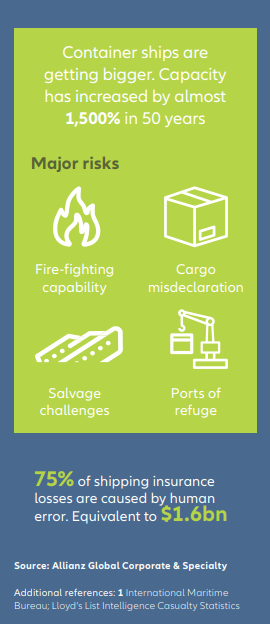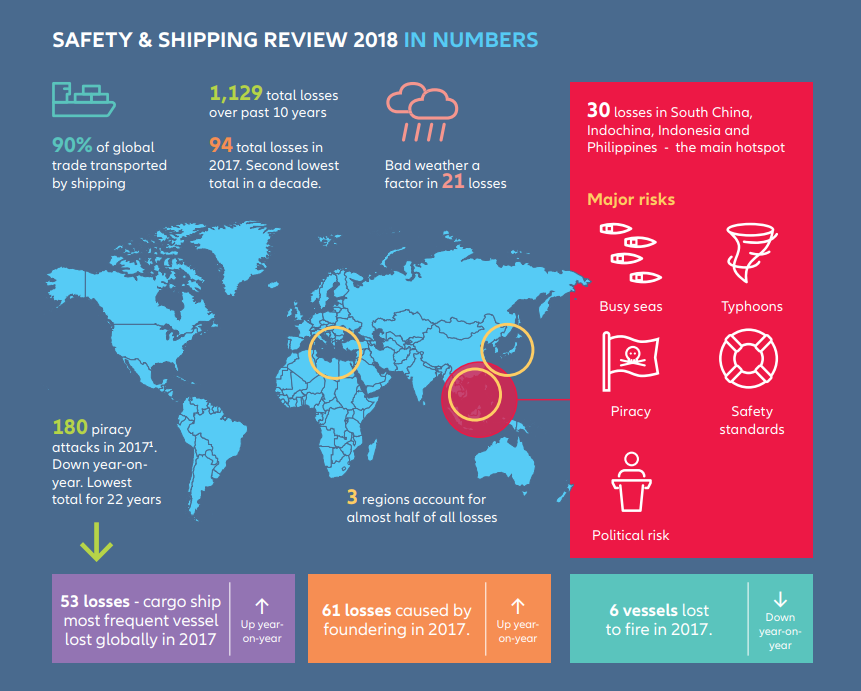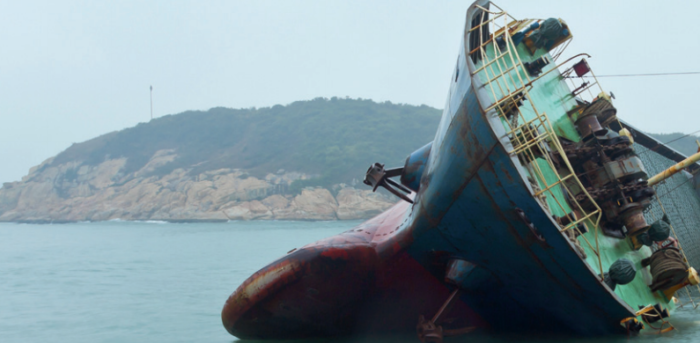In its annual Safety and Shipping Review, Allianz revealed that 2017 saw the second lowest total of shipping losses over the past decade. In 2017, losses figures decreased slightly by 4%, from 98 to 94, but losses in the last ten years have declined by more than a third (38%), driven by improved ship design, technology and advances in risk management and safety, as well as recent lower shipping activity.
Highlights
- The South China, Indochina, Indonesia and Philippines maritime region has been the number one area worldwide for major shipping incidents
 for the past decade, leading some media commentators to call it the “new Bermuda Triangle”.
for the past decade, leading some media commentators to call it the “new Bermuda Triangle”. - Last year, 32% of losses occurred here (30) – up 25% annually.
- Not only are the seas busy, they are also prone to bad weather – in 2017 Typhoon Damrey contributed to 6 losses.
- The East Mediterranean and Black Sea region is the second major loss hotspot (17), followed by the British Isles (8) and the Arabian Gulf (6).
- Cargo ships (53) account for over half of all vessels lost during 2017, with activity up annually by 56%, driven by a rise in sinking incidents.
- Fishing and passenger vessel losses are down year-on-year.
- Losses involving bulk carriers and tankers increased, with bulk carriers accounting for five of the 10 largest reported total losses by GT.
- Foundering has been the cause of over half of the 1,129 total losses reported over the past decade. It accounted for an even higher share of 2017 losses (65%), with bad weather often a factor.
- Wrecking/stranding ranks second (13), followed by machinery damage/failure (8).
- Fire/explosion losses declined year-on-year (6).
- There were 2,712 reported casualties in 2017, up slightly year-on-year by 3%, driven by a rise in machinery damage incidents – the top cause of casualties around the globe (42%).
- The East Mediterranean and Black Sea region is the most frequent location for incidents.
Other findings
Behavioral and cultural risk needs addressing
Human error continues to be a major driver of incidents and captains and crews are under increasing commercial pressure as supply chains are streamlined. Tight schedules can have a detrimental effect on safety culture and decision-making leading to the “normalization of risk”.
Better use of data and analytics can help to address this. The shipping industry has learned from losses in the past but predictive analysis is important for the future. New insights from crew behavior and near-misses can help identify human error trends. Sensor technology can also enhance risk management. For example, hull stress monitoring sensors could be linked to ship navigation in bad weather, feeding real-time information on structural integrity. However, over-reliance on technology on board must be avoided. Continual training is imperative to ensure the right balance is achieved between technology and human intervention.
Industry’s struggle with container ship fires continues
- Major fires on container vessels are one of the most significant safety issues. The blaze on the ultra-large container ship (ULCS) Maersk Honam in March 2018 is one of a number of incidents in recent years.
- Issues driving container ship fire exposures include the adequacy of firefighting capabilities as vessels become larger, misdeclaration of cargo, salvage challenges and time taken to access a port of refuge. ULCS provide economies of scale but the industry needs to ensure risk management standards are up to speed, as larger container ships are on their way.

Record-breaking hurricane season brings supply chain and yacht problems
- Hurricanes Harvey, Irma and Maria (HIM) and other severe weather events in 2017, such as Typhoons Damrey and Hato, show traditional maritime risks should not be overlooked.
- AGCS analysis shows bad weather directly contributed to at least 21 total losses in 2017 and this could yet increase further.
- Fuel market, cargo, cruise ship and port operations were also disrupted, leading to natural catastrophes being ranked the top risk by shipping experts in the Allianz Risk Barometer 2018.
- Meanwhile, the estimated 60,000 pleasure craft damaged or destroyed by HIM in the US and Caribbean raises questions over the insurability of such vessels remaining in the region during the season.
Fast-changing ice conditions bring route risks
- Cargo volumes on the Northern Sea Route increased by nearly 40% to 9.7 million tons over the past year – the biggest annual volume ever.
- China has also announced plans for an “Arctic Silk Road”, developing shipping lanes opened up by global warming.
- There were 71 reported shipping incidents in Arctic Circle waters during 2017, up 29% year-on-year. Arctic conditions can change quickly and transit information will need to be disseminated faster than at present in future.
- Ice also poses a significant hazard elsewhere. Over 1,000 icebergs drifted into North Atlantic shipping lanes in 2017 – the fourth consecutive “extreme” season.
Exploitation of the seas increases
- The marine environment is seen as a resource, bringing environmental risks for shipping, such as pollution of fish farms or even pirate fishing, which is estimated to cost the global economy as much as $23.5bn a year.
- Increasing maritime activity also brings potential new collision hazards, such as the growing number of offshore wind farms in the North Sea – offshore wind In Europe grew 25% in 2017; a record year.
New emissions rules problematic
- The shipping industry is increasingly looking to technical solutions to reduce emissions, which could bring accompanying risk issues with engines and bunkering of biofuels, as well as questions over appropriate training of crew.
- The reduction in sulphur emissions by 2020 comes with cost implications and doubts over sufficient availability of affordable low-sulphur fuel. Exhaust gas-cleaning systems or “scrubbers” are costly, with demand outstripping supply. Compliance is likely to be problematic and industry preparation lacking.
Shippers get serious on cyber
- Major attacks, such as NotPetya, which caused around $3bn of economic losses, have created a renewed urgency in tackling the threats posed to vessels and the supply chain, as well as increasing interest in cyber business interruption insurance. The current lack of incident reporting masks the true picture in shipping when it comes to cyber risk.
- New regulations such as the European Union’s Network and Information Security Directive will change that and also exacerbate the fall-out from any cyber failure.
Drones ready for take-off
Unmanned aircraft systems are increasingly used by class societies and marine surveyors to assess vessel damage and more uses are likely in future, which could have the potential to make a significant contribution to safety and risk management. These include assessing environmental pollution, monitoring cargo loading and pirate activity along coastlines and carrying out cargo tank inspections. Drones could enable faster, more informed decision-making on board, reducing the impact of any incident.
Autonomous shipping progresses but challenges remain
- Autonomous shipping could improve maritime safety but will not remove human error entirely. It will still be present in the algorithms that drive the decision-making of vessels, while manned onshore bases will continue to control and monitor.
- Automation raises questions about who is at fault in an accident – the manufacturer, software provider or the onshore bases.
- New kinds of losses, such as cyber or product liability, could replace traditional claims.
- Technical management and maintenance of ships will also need to be rethought.
- One of the main challenges for the insurance industry in future will be dealing with more technical shipping claims, resulting from greater use of new technology.
Political risk and piracy still rule the waves
Heightened political tensions around major shipping routes, such as off the coast of Yemen in the Middle East and the South China Sea in Asia, pose a risk of disruption.
- Although piracy incidents have dropped to a 22-year low (180 attacks) , hotspots remain.
- Three quarters of incidents occur in South East Asia and Africa.
- Indonesia (43 attacks) remains the main location although activity has declined.
- Conversely, activity in the Philippines more than doubled yearon-year (22 attacks).
- In Africa, there was an increase in Somalian piracy.
- In South America, Venezuela saw a significant increase in piracy activity, with one happening every month on average during 2017.
Explore more herebelow:
































































